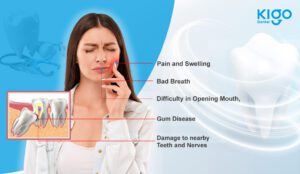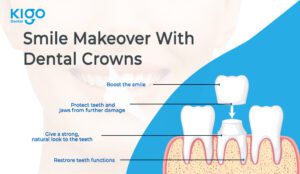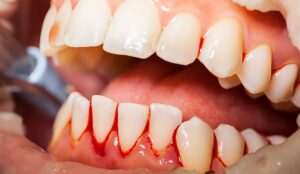Orthodontic Braces / Treatments
Uncompromised quality
We use quintessential quality materials and stringent sterilisation protocols to ensure that you don't have any medical or dental complications in future.
Anxiety Free Dentistry
Experience the treatment process in a pleasant atmosphere from handpicked expert clinicians, with unparalleled clinical etiquette, to ensure exemplary health care.
Best in class outcomes
We strive our best, so that we can keep our promise of delivering the individualized smiles that we have reimagined for you with latest techniques and technologies.
Orthodontic Braces


We understand that achieving a straight, aligned smile is a goal for many individuals, and at Kigo Dental, we are here to help you transform your smile with our comprehensive Orthodontic Braces service. Our experienced orthodontic team is dedicated to providing you with the highest quality of care and creating beautiful, confident smiles that last a lifetime.
Orthodontic braces are a time-tested and highly effective solution for correcting a wide range of orthodontic issues, including crooked teeth, overcrowding, gaps, overbites, underbites, and misalignments. With our advanced orthodontic techniques and state-of-the-art technology, we can tailor a treatment plan to address your specific needs, giving you the smile you’ve always dreamed of.
During your initial consultation, our skilled orthodontists will conduct a thorough examination, utilizing diagnostic tools such as X-rays, photographs, and impressions to evaluate the current state of your teeth and bite. Based on this assessment, we will develop a personalized treatment plan that outlines the recommended course of action and estimated treatment duration.
At Kigo Dental, we offer a variety of orthodontic braces options to suit your preferences and lifestyle. Traditional metal braces are a durable and cost-effective choice, utilizing high-quality brackets and wires to gradually shift your teeth into their proper positions. For those seeking a more discreet option, we also provide tooth-colored ceramic braces that blend seamlessly with your natural teeth, offering a more subtle and aesthetic treatment experience.
Throughout your orthodontic journey, our team will closely monitor your progress, ensuring that your braces are adjusted at regular intervals to maintain steady progress and achieve optimal results. We will also provide you with thorough guidance on oral hygiene practices and any necessary dietary adjustments to promote good oral health and maximize the effectiveness of your treatment.
At Kigo Dental, we are committed to providing you with outstanding orthodontic care in a comfortable and friendly environment. Our team of experts will work closely with you to ensure that your orthodontic treatment is tailored to your unique needs, delivering exceptional results and a smile that you can be proud of.
Take the first step towards a straighter, healthier smile by scheduling a consultation with Kigo Dental today. Let us help you embrace the transformative power of orthodontic braces and achieve the confident, beautiful smile you deserve.
Metal Braces: Traditional metal braces are made of stainless steel and are the most common type of braces. They are also the most noticeable, but they are effective and durable.
Ceramic Braces: Ceramic braces are similar to metal braces, but they are made of clear or tooth-colored materials, making them less noticeable.
Lingual Braces: Lingual braces are similar to metal braces, but they are attached to the inside of the teeth, making them nearly invisible.
Invisalign: Invisalign is a clear, removable aligner that gradually moves teeth into proper alignment. It is a popular alternative to traditional braces.
Self-Ligating Braces: Self-ligating braces are similar to traditional braces, but they use special clips instead of elastic bands to hold the archwire in place.
Damon Braces: Damon braces are self-ligating braces that use a sliding mechanism to hold the archwire in place.
Initial consultation: The first step is to schedule a consultation with an orthodontist, who will evaluate the condition of your teeth and jaws, and recommend the most suitable braces treatment plan.
Treatment planning: Once the orthodontist has assessed your dental condition, they will develop a personalized treatment plan based on your specific needs. This plan will include the type of braces that will be used, the duration of treatment, and the cost involved.
Braces installation: The next step is to install the braces. The orthodontist will first clean and dry your teeth, and then bond the brackets to the teeth with a special adhesive. The archwire is then threaded through the brackets and secured in place with elastic bands.
Adjustments: Throughout the course of treatment, you will need to visit your orthodontist periodically for adjustments to your braces. During these appointments, the archwire will be tightened or replaced, and the elastics will be adjusted to help move your teeth into their correct positions.
Oral hygiene: Maintaining good oral hygiene is essential during braces treatment. You will need to brush and floss your teeth regularly to prevent plaque buildup and tooth decay.
Completion of treatment: Once your teeth have been aligned to their desired positions, the braces will be removed. Your orthodontist may also provide you with a retainer to wear after the braces are removed, which will help to maintain the alignment of your teeth.
Straight Teeth: Braces can effectively straighten misaligned, crowded, or gapped teeth, leading to a more attractive smile.
Improved Oral Health: Straight teeth are easier to clean and maintain, reducing the risk of tooth decay, gum disease, and other oral health problems.
Correct Bite Issues: Orthodontic braces can also correct bite issues, such as overbite, underbite, and crossbite, which can cause discomfort and jaw pain.
Increased Confidence: A straighter, healthier smile can boost self-esteem and confidence, leading to improved overall well-being.
Long-lasting Results: With proper care and maintenance, the results of orthodontic treatment with braces can be long-lasting, helping to maintain a straight and healthy smile for years to come.
Discomfort and Pain: Braces can cause initial discomfort and pain, especially during the adjustment period. This is usually temporary and can be managed with over-the-counter pain relievers.
Mouth Sores: Braces can irritate the inside of the mouth, causing sores and ulcers. This can be relieved by using orthodontic wax or rinsing with salt water.
Loose or Broken Brackets: Brackets can come loose or break during treatment, causing discomfort and extending the treatment time.
Decay and Staining: Braces can make it more difficult to clean teeth, increasing the risk of tooth decay and staining. It is important to follow proper oral hygiene practices to minimize these risks.
Root Resorption: In some cases, braces can cause root resorption, which is the shrinking or disappearing of the roots of the teeth.
Delayed Treatment Time: Treatment with braces can take several months to several years, depending on the severity of the case, which can be frustrating for some patients.
Here are some general instructions you may receive:
Oral hygiene: Maintaining good oral hygiene is essential during braces treatment. You will need to brush and floss your teeth regularly to prevent plaque buildup and tooth decay. Your orthodontist may recommend using special tools, such as interdental brushes or a water flosser, to help clean between the brackets and wires.
Diet: You may need to avoid certain foods during braces treatment to prevent damage to the brackets or wires. Hard, sticky, or chewy foods can be particularly problematic, as they can dislodge the braces or cause them to break. Your orthodontist may provide you with a list of foods to avoid or suggest alternative options.
Adjustments: Throughout the course of treatment, you will need to visit your orthodontist periodically for adjustments to your braces. These appointments are important to ensure that the braces are working effectively and to make any necessary adjustments to the wires or brackets.
Pain management: It’s common to experience some discomfort or soreness after your braces are first installed or after an adjustment. Your orthodontist may recommend over-the-counter pain relievers, such as ibuprofen or acetaminophen, to help manage the pain. Eating soft foods and using a warm compress may also provide relief.
Emergencies: If you experience any issues with your braces, such as a broken wire or bracket, contact your orthodontist as soon as possible. They can advise you on the best course of action and may need to schedule an emergency appointment to make repairs.
Wear-time: It’s essential to wear your braces for the recommended amount of time each day. If you have removable aligners or retainers, you will need to wear them for the recommended amount of time each day to ensure that your teeth remain in their corrected positions.
Braces treatment is important for several reasons. Here are some of the key benefits of orthodontic treatment with braces:
Improved oral health: Crooked or crowded teeth can be difficult to clean properly, which can increase the risk of tooth decay, gum disease, and other oral health problems. By straightening the teeth, braces treatment can make it easier to keep the teeth and gums healthy.
Enhanced appearance: Many people feel self-conscious about their crooked or misaligned teeth. Braces can help improve the appearance of the teeth and give patients a more attractive smile.
Better bite: When the teeth are misaligned, it can cause problems with the bite, which can lead to headaches, jaw pain, and other issues. Braces treatment can correct these issues and improve the function of the jaw and teeth.
Increased confidence: A straight, healthy smile can boost self-esteem and confidence, leading to improved social and professional interactions.
Long-term benefits: Orthodontic treatment with braces can have long-lasting benefits, including better oral health, improved appearance, and a more functional bite.
All of us here at Kigo Dental are committed to providing you with the best dental care available, and we do so with a smile.
Our entire staff, from receptionists to dental hygienists and assistants, is committed to providing you with the best quality dental care possible
From the time you walk through the door and every time you revisit, you will experience this firsthand.
Kigo Dental has a team of experienced and skilled Orthodontists and other specialised dentists who specialise in providing high-quality dental care and treatments, utilising the latest technologies and techniques to ensure the best outcomes for their patients.
FAQ's
Orthodontic braces are devices used to correct misaligned teeth and jaws. They consist of brackets, wires, and bands that are attached to the teeth and work to gently shift them into the correct position.
The length of orthodontic treatment varies from person to person, but it usually takes between 12 to 36 months. The duration of treatment depends on the severity of the dental problems and the type of braces used.
There may be some discomfort when the braces are first applied, or when the wires are tightened, but it is generally not painful. Over-the-counter pain relievers and orthodontic wax can be used to relieve any discomfort.
Yes, you can eat with braces, but there are certain foods that should be avoided as they can damage the braces or get stuck between the brackets and wires. These include hard and sticky foods such as candy, ice, and popcorn etc.
Yes, it is important to brush and floss regularly to maintain good oral hygiene during orthodontic treatment. An interdental brush may also be used to clean between the wires and brackets.
Orthodontic braces are designed to be worn for the entire length of treatment, but in some cases, they may be removed earlier if the desired results have been achieved. It is important to follow the instructions of your orthodontist and not remove the braces on your own.
Blogs











Wisdom Teeth: Understanding the What, Why, and When
Wisdom teeth, also known as third molars, are often a source of concern for many people. They can lead to various dental issues, including wisdom











Smile Makeover with Dental Crowns: Types, Overview & cost
A smile is one of the most attractive features a person can have. It can boost your confidence, make you more approachable, and even improve











Beyond the smile: Exploring the crucial role of teeth in your overall health
Teeth are often linked to the ability to smile, eat, and express oneself. However, teeth serve many other vital purposes as well. Your teeth have











The Silent Threat: How Gum Diseases Lead to Tooth Loss
Having strong teeth and gums is a reflection of your entire well-being, not simply your appearance. Despite this, many people don’t give their gums the











The Importance of Orthodontists in Clear Aligner Treatment: Avoiding Problems and Ensuring Successful Outcomes
More and more individuals are seeking out clear aligner treatment as a way to improve their smile in a way that is both subtle and











Understanding Abnormal Dental Habits in Children and the Importance of Control
As parents and caregivers, we play a pivotal role in shaping our children’s habits and behaviors, especially when it comes to their oral health. However,











Wisdom Teeth: Understanding the What, Why, and When
Wisdom teeth, also known as third molars, are often a source of concern for many people. They can lead to various dental issues, including wisdom











Smile Makeover with Dental Crowns: Types, Overview & cost
A smile is one of the most attractive features a person can have. It can boost your confidence, make you more approachable, and even improve











Beyond the smile: Exploring the crucial role of teeth in your overall health
Teeth are often linked to the ability to smile, eat, and express oneself. However, teeth serve many other vital purposes as well. Your teeth have











The Silent Threat: How Gum Diseases Lead to Tooth Loss
Having strong teeth and gums is a reflection of your entire well-being, not simply your appearance. Despite this, many people don’t give their gums the











The Importance of Orthodontists in Clear Aligner Treatment: Avoiding Problems and Ensuring Successful Outcomes
More and more individuals are seeking out clear aligner treatment as a way to improve their smile in a way that is both subtle and











Understanding Abnormal Dental Habits in Children and the Importance of Control
As parents and caregivers, we play a pivotal role in shaping our children’s habits and behaviors, especially when it comes to their oral health. However,











Wisdom Teeth: Understanding the What, Why, and When
Wisdom teeth, also known as third molars, are often a source of concern for many people. They can lead to various dental issues, including wisdom











Smile Makeover with Dental Crowns: Types, Overview & cost
A smile is one of the most attractive features a person can have. It can boost your confidence, make you more approachable, and even improve











Beyond the smile: Exploring the crucial role of teeth in your overall health
Teeth are often linked to the ability to smile, eat, and express oneself. However, teeth serve many other vital purposes as well. Your teeth have











The Silent Threat: How Gum Diseases Lead to Tooth Loss
Having strong teeth and gums is a reflection of your entire well-being, not simply your appearance. Despite this, many people don’t give their gums the











The Importance of Orthodontists in Clear Aligner Treatment: Avoiding Problems and Ensuring Successful Outcomes
More and more individuals are seeking out clear aligner treatment as a way to improve their smile in a way that is both subtle and











Understanding Abnormal Dental Habits in Children and the Importance of Control
As parents and caregivers, we play a pivotal role in shaping our children’s habits and behaviors, especially when it comes to their oral health. However,











Wisdom Teeth: Understanding the What, Why, and When
Wisdom teeth, also known as third molars, are often a source of concern for many people. They can lead to various dental issues, including wisdom











Smile Makeover with Dental Crowns: Types, Overview & cost
A smile is one of the most attractive features a person can have. It can boost your confidence, make you more approachable, and even improve











Beyond the smile: Exploring the crucial role of teeth in your overall health
Teeth are often linked to the ability to smile, eat, and express oneself. However, teeth serve many other vital purposes as well. Your teeth have











The Silent Threat: How Gum Diseases Lead to Tooth Loss
Having strong teeth and gums is a reflection of your entire well-being, not simply your appearance. Despite this, many people don’t give their gums the











The Importance of Orthodontists in Clear Aligner Treatment: Avoiding Problems and Ensuring Successful Outcomes
More and more individuals are seeking out clear aligner treatment as a way to improve their smile in a way that is both subtle and











Understanding Abnormal Dental Habits in Children and the Importance of Control
As parents and caregivers, we play a pivotal role in shaping our children’s habits and behaviors, especially when it comes to their oral health. However,











Wisdom Teeth: Understanding the What, Why, and When
Wisdom teeth, also known as third molars, are often a source of concern for many people. They can lead to various dental issues, including wisdom











Smile Makeover with Dental Crowns: Types, Overview & cost
A smile is one of the most attractive features a person can have. It can boost your confidence, make you more approachable, and even improve











Beyond the smile: Exploring the crucial role of teeth in your overall health
Teeth are often linked to the ability to smile, eat, and express oneself. However, teeth serve many other vital purposes as well. Your teeth have











The Silent Threat: How Gum Diseases Lead to Tooth Loss
Having strong teeth and gums is a reflection of your entire well-being, not simply your appearance. Despite this, many people don’t give their gums the











The Importance of Orthodontists in Clear Aligner Treatment: Avoiding Problems and Ensuring Successful Outcomes
More and more individuals are seeking out clear aligner treatment as a way to improve their smile in a way that is both subtle and











Understanding Abnormal Dental Habits in Children and the Importance of Control
As parents and caregivers, we play a pivotal role in shaping our children’s habits and behaviors, especially when it comes to their oral health. However,
Kigo Dental: Transforming Smiles with Expert Orthodontic Care!


A straight, well-aligned smile not only enhances your appearance but also plays a crucial role in maintaining optimal oral health. At Kigo Dental, we are dedicated to providing exceptional orthodontic care, helping patients of all ages achieve the beautiful, confident smiles they deserve.
Our highly skilled orthodontic team understands that every patient is unique, and we approach each case with personalized attention and tailored treatment plans. Whether you’re dealing with crooked teeth, overcrowding, gaps, or bite irregularities, we offer a comprehensive range of orthodontic solutions to address your specific needs and goals.
With the latest advancements in orthodontic technology, we can offer you a variety of treatment options designed for maximum comfort, efficiency, and aesthetic appeal. From traditional braces to discreet options like clear aligners, our orthodontic specialists will guide you in choosing the most suitable treatment modality to achieve your desired results.
At Kigo Dental, we prioritize open communication and patient education throughout the orthodontic journey. Our team will thoroughly evaluate your oral health, discuss your concerns, and explain all available treatment options. We believe in empowering our patients with the knowledge and understanding necessary to make informed decisions about their orthodontic care.
Throughout your orthodontic treatment, our dedicated professionals will provide regular check-ups, adjustments, and ongoing support to ensure the best possible outcome. We embrace a comprehensive approach to oral health, considering the long-term benefits of orthodontic treatment in achieving a harmonious and functional smile.
Whether you’re an adult seeking a discreet orthodontic correction or a parent exploring orthodontic options for your child, Kigo Dental is here to guide you on your path to a straighter, healthier smile. Don’t wait any longer to transform your dental alignment and boost your self-confidence. Schedule a consultation with our expert orthodontic team today and take the first step toward achieving the smile you’ve always desired.
Initial Consultation: Your first step is to schedule a consultation with an orthodontist. During this appointment, the orthodontist will examine your teeth, jaws, and bite to determine the best course of treatment. They will also take x-rays and photos of your teeth and jaws to create a treatment plan.
Impressions and Models: If you decide to proceed with orthodontic treatment, the next step is to have impressions and models made of your teeth. These models are used to create custom-fit orthodontic appliances such as braces or aligners.
Bonding or Placement of Braces: If you are getting braces, the orthodontist will bond the brackets to your teeth and attach the wires to the brackets. The braces will be adjusted regularly to gradually move your teeth into the desired position.
Clear Aligner Treatment: If you are getting clear aligners, the orthodontist will create a series of custom-fit aligners for you to wear. You will need to wear each set of aligners for a specified period of time before switching to the next set in the series.
Regular Adjustments: Regardless of the type of orthodontic treatment you choose, you will need to visit the orthodontist regularly for adjustments. This is important to ensure that your treatment is progressing as planned and to make any necessary adjustments to your orthodontic appliances.
Retainer Wear: Once your orthodontic treatment is complete, you will need to wear a retainer to keep your teeth in their new positions. Your orthodontist will advise you on how long you need to wear your retainer and how often to wear it.
Improved Oral Health: Straight teeth are easier to clean and less likely to develop dental problems such as cavities, gum disease, and tooth decay. Orthodontic treatment can help to improve your overall oral health by ensuring that your teeth are aligned properly and that you can brush and floss effectively.
Better Bite: Orthodontic treatment can help to correct bite problems, such as overbite, underbite, and crossbite. A proper bite can improve your ability to chew and speak, as well as reduce the risk of jaw pain and headaches.
Enhanced Appearance: Straight teeth and a properly aligned jaw can significantly improve the appearance of your smile. Orthodontic treatment can help to boost your self-confidence and improve your overall quality of life.
Increased Longevity of Teeth: Orthodontic treatment can help to ensure that your teeth last a lifetime by preventing damage to your teeth and gums. By correcting misaligned teeth, orthodontic treatment can also help to reduce the risk of tooth loss and gum disease.
Improved Speech: Orthodontic treatment can help to correct speech impediments that misaligned teeth or jaws may cause. A proper bite can improve your ability to articulate words and speak more clearly.
Eased Tension and Pain: Orthodontic treatment can help to relieve jaw and neck pain, headaches, and other symptoms that may be caused by bite problems. By correcting your bite and aligning your teeth, orthodontic treatment can also help to reduce stress on your jaw joints and muscles.
Better Overall Health: Properly aligned teeth and jaws can improve your overall health by reducing the risk of tooth decay, gum disease, and jaw problems. Straight teeth can also help to improve your ability to eat a balanced diet and reduce the risk of digestive problems.
Schedule a Consultation: The first step in the orthodontic treatment process is to schedule a consultation with an orthodontist. During this appointment, your orthodontist will examine your teeth, jaws, and bite, and discuss your treatment options with you.
Clean Your Teeth: It’s important to have clean teeth before starting orthodontic treatment. This means brushing and flossing regularly and having a professional dental cleaning if necessary.
X-rays and Impressions: Your orthodontist may need to take X-rays and dental impressions to get a better idea of your teeth and jaws. These images will help your orthodontist to plan your treatment and determine the best course of action for your individual needs.
Discuss Medical History: Before starting orthodontic treatment, it’s important to discuss your medical history with your orthodontist. This includes any medications you are taking, any allergies you have, and any other relevant information that may impact your treatment.
Remove Decorative Items: If you have any decorative items, such as piercings or temporary tattoos, in your mouth, it’s important to remove them before starting orthodontic treatment.
Make Lifestyle Changes: Depending on your treatment plan, you may need to make some lifestyle changes before starting orthodontic treatment. For example, if you are getting braces, you may need to limit your consumption of sugary or sticky foods.
Prepare for Discomfort: Orthodontic treatment can cause mild to moderate discomfort, especially after adjustments or when switching to a new set of aligners. It’s important to prepare for this discomfort by stocking up on over-the-counter pain medication and planning to eat soft foods.
Wear Your Appliances as Directed: Whether you have braces, aligners, or another type of orthodontic appliance, it’s important to wear them as directed by your orthodontist. This includes wearing them for the recommended amount of time each day and avoiding activities that can damage or dislodge the appliances.
Clean Your Teeth Regularly: Good oral hygiene is essential during orthodontic treatment. This means brushing and flossing regularly and visiting your dentist for regular cleanings. Your orthodontist may also provide you with specific instructions for cleaning your orthodontic appliances.
Attend Adjustment Appointments: Your orthodontist will schedule adjustment appointments to check on your progress and make any necessary changes to your appliances. It’s important to attend these appointments as scheduled.
Limit Certain Foods: Depending on your treatment plan, you may need to limit your consumption of certain foods, such as sugary or sticky foods, to ensure the best possible outcome.
Use a Mouthguard: If you play contact sports, it’s important to use a mouthguard to protect your teeth and jaws during orthodontic treatment.
Treat any Discomfort: Orthodontic treatment can cause mild to moderate discomfort, especially after adjustments or when switching to a new set of aligners. It’s important to treat this discomfort promptly with over-the-counter pain medication or other remedies recommended by your orthodontist.
Report any Problems: If you experience any problems with your orthodontic appliances or have any questions or concerns about your treatment, it’s important to report these to your orthodontist promptly.
There are several signs that may indicate the need for orthodontic treatment. If you experience any of the following issues, it is recommended to consult with an orthodontist for a comprehensive evaluation:
Crooked or crowded teeth: Teeth that are crooked, twisted, or overlapping can cause problems with biting, chewing, and cleaning, and may indicate the need for orthodontic treatment.
Overbite or underbite: An overbite occurs when the upper front teeth protrude over the lower teeth, while an underbite occurs when the lower jaw protrudes forward, causing the lower teeth to overlap the upper teeth. Both of these conditions can cause problems with biting, speech, and aesthetics.
Crossbite: A crossbite occurs when the upper teeth bite inside the lower teeth. This can cause problems with biting, chewing, and jaw growth.
Open bite: An open bite occurs when there is a gap between the upper and lower teeth when the mouth is closed. This can cause problems with biting, chewing, and speech.
Early or late loss of baby teeth: If baby teeth are lost too early or too late, it can affect the alignment of the permanent teeth and may require orthodontic treatment.
Difficulty biting or chewing: Problems with biting or chewing may indicate issues with the alignment of the teeth and jaw.
Mouth breathing: Mouth breathing may indicate problems with the development of the jaws and may require orthodontic treatment.
Speech problems: People with speech irregularities & difficulties can benefit from orthodontic treatment.
All of us here at Kigo Dental are committed to providing you with the best dental care available, and we do so with a smile.
Our entire staff, from receptionists to dental hygienists and assistants, is committed to providing you with the best quality dental care possible
From the time you walk through the door and every time you revisit, you will experience this firsthand.
Kigo Dental has a team of experienced and skilled Orthodontists and other specialised dentists who specialise in providing high-quality dental care and treatments, utilising the latest technologies and techniques to ensure the best outcomes for their patients.
FAQ's
Orthodontic braces are devices used to correct misaligned teeth and jaws. They consist of brackets, wires, and bands that are attached to the teeth and work to gently shift them into the correct position.
The length of orthodontic treatment varies from person to person, but it usually takes between 12 to 36 months. The duration of treatment depends on the severity of the dental problems and the type of braces used.
There may be some discomfort when the braces are first applied, or when the wires are tightened, but it is generally not painful. Over-the-counter pain relievers and orthodontic wax can be used to relieve any discomfort.
Yes, you can eat with braces, but there are certain foods that should be avoided as they can damage the braces or get stuck between the brackets and wires. These include hard and sticky foods such as candy, ice, and popcorn etc.
Yes, it is important to brush and floss regularly to maintain good oral hygiene during orthodontic treatment. An interdental brush may also be used to clean between the wires and brackets.
Orthodontic braces are designed to be worn for the entire length of treatment, but in some cases, they may be removed earlier if the desired results have been achieved. It is important to follow the instructions of your orthodontist and not remove the braces on your own.
Blogs











Wisdom Teeth: Understanding the What, Why, and When
Wisdom teeth, also known as third molars, are often a source of concern for many people. They can lead to various dental issues, including wisdom











Smile Makeover with Dental Crowns: Types, Overview & cost
A smile is one of the most attractive features a person can have. It can boost your confidence, make you more approachable, and even improve











Beyond the smile: Exploring the crucial role of teeth in your overall health
Teeth are often linked to the ability to smile, eat, and express oneself. However, teeth serve many other vital purposes as well. Your teeth have











The Silent Threat: How Gum Diseases Lead to Tooth Loss
Having strong teeth and gums is a reflection of your entire well-being, not simply your appearance. Despite this, many people don’t give their gums the











The Importance of Orthodontists in Clear Aligner Treatment: Avoiding Problems and Ensuring Successful Outcomes
More and more individuals are seeking out clear aligner treatment as a way to improve their smile in a way that is both subtle and











Understanding Abnormal Dental Habits in Children and the Importance of Control
As parents and caregivers, we play a pivotal role in shaping our children’s habits and behaviors, especially when it comes to their oral health. However,











Wisdom Teeth: Understanding the What, Why, and When
Wisdom teeth, also known as third molars, are often a source of concern for many people. They can lead to various dental issues, including wisdom











Smile Makeover with Dental Crowns: Types, Overview & cost
A smile is one of the most attractive features a person can have. It can boost your confidence, make you more approachable, and even improve











Beyond the smile: Exploring the crucial role of teeth in your overall health
Teeth are often linked to the ability to smile, eat, and express oneself. However, teeth serve many other vital purposes as well. Your teeth have











The Silent Threat: How Gum Diseases Lead to Tooth Loss
Having strong teeth and gums is a reflection of your entire well-being, not simply your appearance. Despite this, many people don’t give their gums the











The Importance of Orthodontists in Clear Aligner Treatment: Avoiding Problems and Ensuring Successful Outcomes
More and more individuals are seeking out clear aligner treatment as a way to improve their smile in a way that is both subtle and











Understanding Abnormal Dental Habits in Children and the Importance of Control
As parents and caregivers, we play a pivotal role in shaping our children’s habits and behaviors, especially when it comes to their oral health. However,











Wisdom Teeth: Understanding the What, Why, and When
Wisdom teeth, also known as third molars, are often a source of concern for many people. They can lead to various dental issues, including wisdom











Smile Makeover with Dental Crowns: Types, Overview & cost
A smile is one of the most attractive features a person can have. It can boost your confidence, make you more approachable, and even improve











Beyond the smile: Exploring the crucial role of teeth in your overall health
Teeth are often linked to the ability to smile, eat, and express oneself. However, teeth serve many other vital purposes as well. Your teeth have











The Silent Threat: How Gum Diseases Lead to Tooth Loss
Having strong teeth and gums is a reflection of your entire well-being, not simply your appearance. Despite this, many people don’t give their gums the











The Importance of Orthodontists in Clear Aligner Treatment: Avoiding Problems and Ensuring Successful Outcomes
More and more individuals are seeking out clear aligner treatment as a way to improve their smile in a way that is both subtle and











Understanding Abnormal Dental Habits in Children and the Importance of Control
As parents and caregivers, we play a pivotal role in shaping our children’s habits and behaviors, especially when it comes to their oral health. However,











Wisdom Teeth: Understanding the What, Why, and When
Wisdom teeth, also known as third molars, are often a source of concern for many people. They can lead to various dental issues, including wisdom











Smile Makeover with Dental Crowns: Types, Overview & cost
A smile is one of the most attractive features a person can have. It can boost your confidence, make you more approachable, and even improve











Beyond the smile: Exploring the crucial role of teeth in your overall health
Teeth are often linked to the ability to smile, eat, and express oneself. However, teeth serve many other vital purposes as well. Your teeth have











The Silent Threat: How Gum Diseases Lead to Tooth Loss
Having strong teeth and gums is a reflection of your entire well-being, not simply your appearance. Despite this, many people don’t give their gums the











The Importance of Orthodontists in Clear Aligner Treatment: Avoiding Problems and Ensuring Successful Outcomes
More and more individuals are seeking out clear aligner treatment as a way to improve their smile in a way that is both subtle and











Understanding Abnormal Dental Habits in Children and the Importance of Control
As parents and caregivers, we play a pivotal role in shaping our children’s habits and behaviors, especially when it comes to their oral health. However,











Wisdom Teeth: Understanding the What, Why, and When
Wisdom teeth, also known as third molars, are often a source of concern for many people. They can lead to various dental issues, including wisdom











Smile Makeover with Dental Crowns: Types, Overview & cost
A smile is one of the most attractive features a person can have. It can boost your confidence, make you more approachable, and even improve











Beyond the smile: Exploring the crucial role of teeth in your overall health
Teeth are often linked to the ability to smile, eat, and express oneself. However, teeth serve many other vital purposes as well. Your teeth have











The Silent Threat: How Gum Diseases Lead to Tooth Loss
Having strong teeth and gums is a reflection of your entire well-being, not simply your appearance. Despite this, many people don’t give their gums the











The Importance of Orthodontists in Clear Aligner Treatment: Avoiding Problems and Ensuring Successful Outcomes
More and more individuals are seeking out clear aligner treatment as a way to improve their smile in a way that is both subtle and











Understanding Abnormal Dental Habits in Children and the Importance of Control
As parents and caregivers, we play a pivotal role in shaping our children’s habits and behaviors, especially when it comes to their oral health. However,
LET'S TALK
Book your Appointment
Appointment Timings: Mon-sat: 10:00 am- 8:00 pm |
Sun: 10:00 am - 1:00 pm
Contact
We would love to be a part of your Smile Reimagining Journey...
- 2nd Floor, QUBE, Plot No: 3-64/A, Kavuri Hills Rd, Jubilee Hills, Hyderabad, Telangana 500033
-
+91 9998884398
- kigodental@gmail.com
-
Mon - Sat: 10:00 am - 8:30 pm
Sun: 10:00 am - 1:00 pm